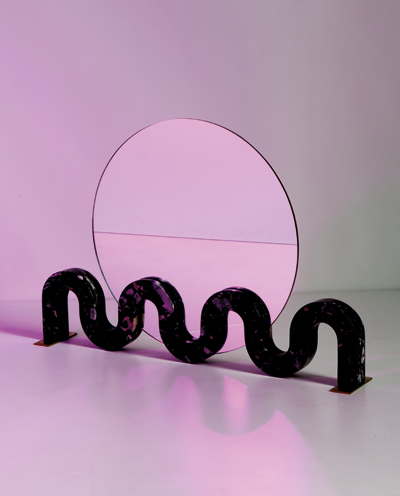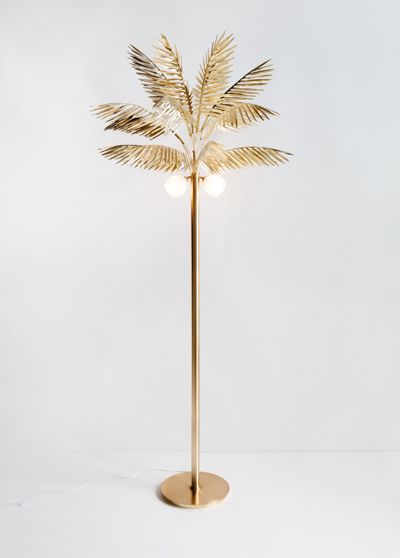|
|
||
|
Brooklyn-based industrial designer Syrette Lew explores the intersections between contrasting styles and periods. In her latest collection, Hollywood Regency meets ancient Rome “My interest lies in distilling elements from a certain context and then pairing them with something from another,” says Brooklyn-based designer Syrette Lew of her second furniture collection as Moving Mountains, which launched at New York’s ICFF in May. “It gives my work a familiarity, a starting point to understand it, but then the juxtaposition makes it feel new and unexpected.” Recontextualisation has been a preoccupation evident in Lew’s work since her debut in 2014. Mashing up Shaker and Memphis references (“two movements that couldn’t be more opposite sides of the spectrum in terms of style and philosophy”), the collection saw her scrambling of the classic Windsor chair, transforming it into a bench, by adding an exaggerated crest more normally found in Shaker furniture, and a lounge chair with rounded, almost cartoonish proportions. Her new collection is similarly inspired by a collision between American and European design traditions, in this case the maximalist grandeur of Hollywood Regency (a loose catch-all for the baroque-influenced style triggered by high-society interior decorator Dorothy Draper and actor-cum-designer Billy Haines) and Lew’s research into forms found in ancient civilisations of Greece and Rome.
The Sine Wave mirror was designed for a pop-up shop for online magazine Sight Unseen Named after the ruined city that linked the Roman empire to the East (situated in modern-day Syria), the Palmyra lamp is a flamboyant but functional floor light made from blown glass and hand-formed brass leaves. Not only does its form nod to classical ornamentation and Lew’s own upbringing (Palmyra gave its name to a palm-tree species found in parts of Hawaii, where Lew was born), but it’s also a motif Lew frequently discovered in 1960s and 70s incarnations of Hollywood Regency. “They were often sculptural: beautiful but totally non-functional. If there was a lighting element, it felt like an afterthought. I wanted to experiment with whether it would work as a real lamp.” Similarly, the repeated cylindrical forms of the Column tables are a modern take on the fluting found in classical Greco-Roman architecture, albeit rendered in a loud Hollywood Regency palette. The engineered marble Sine Wave mirror, created as part of a larger pop-up shop interior for New York-based tastemakers Sight Unseen, was the result of an investigation into new ways of supporting an upright mirror, its slick wiggle akin to the undulating borders of Roman mosaics.
The Palmyra lamp is made from blown glass and hand-formed brass leaves Although Lew’s latest collection – like her first – is made to order in collaboration with local craftsmen and small-scale fabricators, it has a very different feel to the predominantly wooden inaugural pieces. This chameleonic way of working is a strength Lew attributes to her six years at furniture behemoth West Elm, which produces seasonal collections much like the fashion industry. Moving Mountains’ approach may be diametrically opposite in terms of audience and attitudes to permanence, but designing for Middle America furnished Lew with the ability to navigate between different design languages and not feel that she had to be tied to one specific aesthetic. “In many ways I’ve had to unlearn a lot of the things that were ingrained into my design approach,” she says, “but it did give me a really good idea of the big picture.” This “big picture” includes vital insight into the rapid growth of the country’s design industry. “Historically the vast majority of America’s tastes tend towards the conservative and the traditional but that is definitely changing, especially around the coasts,” says Lew. “It’s largely down to social media, Instagram and Pinterest – ideas spread and mutate so much faster. ‘American design’ is finally maturing into a sophisticated, multi-faceted language.” This change is integral to how Lew envisions growing the studio, as demand drives American manufacturing companies to rethink their reluctance to collaborate with younger designers. “I still very much believe in democratic design; I’m very interested in creating products for mass production. Right now my work is not affordable for a wide audience, but with the right partnership it could be.” With its amalgamation of contrasting aesthetics, Lew’s vision offers an elegant solution for a design industry in transition – enticingly new but still reassuringly familiar. |
Words Laura Snoad
Above: The Column tables have fluting inspired by Greco-Roman architecture |
|
|
||



















